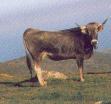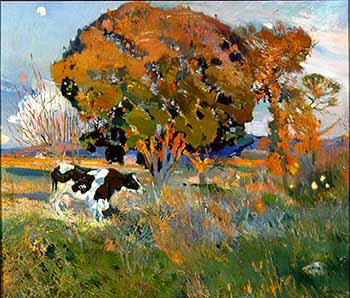 A tudanca, a breed of autocthonous cattle from Cantabria A tudanca, a breed of autocthonous cattle from Cantabria (by Nick Lloyd and Francis Barrett) Although beef now forms an essential part of many Spaniards' diet, there was apparently a paucity of recipes in much of Spain for beef until recent times. This is no surprise in a land where summer drought made it very difficult to raise more than a few heads of cattle. During the Middle Ages, lamb was consumed by Christians, Muslims and Jews, and pork only by Christians, but cows and bulls tended to be working animals used in the fields, and were only slaughtered for food when they were old or sick. It probably wasn't until the 1960's when the Spanish en masse began to eat beef, spurring and spurred on by cheaper, industrially produced meat.
Spain is still the lowest per capita consumer of beef in the EU. This is no doubt partly due to the tradition and quality of pork products and lamb, but also because of the inferiority of some of its beef production: most animals are industrially-raised and fed, and have very little opportunity to develop muscle fibre, being confined to cattle sheds their whole lives.
One of the first things a visitor notices in much of the Spanish countryside is the lack of farm animals in the fields, though this is certainly not the case in the Cordillera Cantábrica and some other mountainous regions, such as parts of Castile y León, where there is a long tradition of beef consumption. Here, cattle tend to roam free and in more recent years, traditional extensive and sometimes "ecological / organic" cattle raising methods have become much more popular and profitable in the Atlantic-Cantabrian strip, Western Castile and the Basque, Navarran and Catalan Pyrenees. Several Denominaciones de Origen have been established for Spanish beef.
Many autochthonous breeds are endangered or extinct, with the vast majority of the country's herd being made up of imported Frisians (Frisianas), Charolais (Charolasas) , Herefords, and Brown Alpine (Parda
Alpina). However, a mixture of local pride and commercial interest in quality beef has saved a number from extinction. (see below)

The Friasian has clearly been around for a long time as this painting (La Encina y La Vaca/ The Holm Oak and the Cow) by Joaquín Mir i Trenxet from 1915 demonstrates
In Spanish, beef is usually termed ternera [calf / veal]. This can be misleading for English-speakers, as the meat is not the pale pink thing sold in Britain and Ireland under that name, but simply the meat from a young(ish) head of cattle, supposedly not more than one year old. I used to think it curious that the meat is not called by the same name as the cow [ vaca 1], as this is not normal in Spanish - unlike English, which often distinguishes between animal and meat (e.g. cow / beef, pig / pork, deer / venison), almost certainly for historical socio-linguistic reasons, viz. the lords of the manor who actually ate the meat in feudal days used French terminology, while the Anglo-Saxon peasants used old English words to refer to the animals in question. Then again, English-speaking butchers will often try to pass off mutton as lamb, and I thought it might be on the same principle (!) that Spanish butchers prefer not to use the word for an adult cow. On the other hand, veal from a milk calf, much more akin to the English notion of veal, is called by the same name as the young animal itself, (ternera) lechal . In fact, Spanish farmers tend to use the word terneros for cattle raised for meat and vacas for those raised for milk.
A buey is an ox, meaning a castrated bull; the meat can be quite tender, but is usually regarded as more suitable for stewing. Uncastrated bulls are of course called toros . Toro de lídia is fighting bull, killed in the bullring, and considered to be a special treat. It does tend to have great flavour, but is often, not very surprisingly, rather tough
|
|
El Toro Amigo. Poetic natural life history by TVE of a fighting bull from its birth, its life in the dehesa until just before its end in the plaza ( 55 min 26 sec). Click on play. More Spain nature videos |
The best Spanish beef and dairy products are usually said to come from Galicia , which has a climate and greenery like Ireland 's, and the uplands of the Catalan province of Girona , also relatively lush. Some people claim that the best beef comes from the Tudanca breed, found almost exclusively in the verdant Cabuérniga and Nansa Valleys in the Cantabrian mountains. Others still lay claim to the meat of Avileña negra ibérica, a hardy breed from the mountains of the Sístema Central in Castile..
Spanish beef comes in several forms, and the cuts are quite different from those in English-speaking countries 2. Chuletones are massive slabs of steak, served on the bone and often rather fatty. Entrecots are smaller, more civilised steaks. Solomillo refers to fillet steak, usually small but delicious. A bistec is a minute steak, more often than not rather bland. These cuts are usually cooked a la plancha or fried.
Roast beef is called rosbif and is served hot or cold, usually if rather oddly accompanied with puré de patatas [mashed potatoes]. Tragically, Yorkshire puddings and horseradish sauce are unknown in Spain . Medallones are medallions, usually served with gravy.
Spanish beef stews are usually good. A good fricandó with rovellons and other seasonal mushrooms is delicious. Cecina is salt cured beef, a delicious speciality of cold, dry mountainous areas, the most famous of which is that of Castille. Here, it is sometimes used in cocidos, though these days it is generally eaten cold as an embutido. Its taste and texture is not unlike good biltong or beef jerky.
Minced beef is used for more exotic dishes, notably steak tartare. A bistec ruso is a sort of hamburger. Hamburguesas are usually more akin to (inferior) British beef-burgers than proper American hamburgers. Cubans use minced beef and rice to make picadillo a la habanera. Argentinean minced beef empanadas are also excellent.
Unsurprisingly, Spanish beef consumption has fallen even further since the Mad Cow crisis. While Spain is considered as a low risk area for Mad Cow's disease, there is some cause for concern. Cases increased from 118 in 2002 to 145 in 2003. Click here for latest news on mad cows in Spain. (42 cases as of June 2005). There is as yet no recorded case of human CJD in Spain . New EU laws to prevent new outbreaks of BSE mean that dead livestock can no longer be left abandoned in the countryside. This appears to have led to increased attacks by Spanish wolves on livestock, which has increased tensions in some areas. There is a growing tendency to set up feeding stations for vultures to combat the catastrophic loss of carrion. See also Vulture Feeding Stations; Mad Cows and Wolves.
Notes:
1. The word vaca refers specifically to a female head of cattle aged more than 36 months
2. Argentine beef is regarded by as the best in the world, and in this area, as in so many others, our gaucho friends look down on Spanish practices. Their principal cuts are called asado de tira, vacío and, rather unappetisingly, entraña [gut]. Their famous matambre (mata hambre) dish is made by stuffing bone sinew ( aleta or vaquero ) with spinach, corn, and olives.
Notes on autochthonous Spanish cows
- Asturiana de la montaña or Casina : breed of Asturian cow with a reddish hide and black rings around its eyes. Currently endangered. In theory, provides milk for casin cheese. Asturiana de los valles . Much larger.
- Avileña negra ibérica. Black. Mountains of the Sistema Central in Castile . Top quality meat. One of the oldest breeds in Europe .
- Blanca cacereña : white, sporting hooked horns. Raised for meat. Cáceres y Badajoz.
- Berrenda en colorado/en negro . Generally for transport. Western Andalusia
- Alistana Sanabresa . Chestnut. Raised for meat. Aliste and Sanabria ( Zamora ).
- Caldeana : black, long-horned. Raised for meat. Restricted to the county of Castrocaldelas (Ourense).
- Cardena Andaluza : Black, grey cow with large papada from Andalusia. Transport. and meat. Critically endangered. In the early 1990's just 7 breeding females remained. Adapted to dehesa lands. Lives together with the fighting bulls.
- Lidia : generally black. Bred for the classic Spanish fighting bull. Andalucia, Salamanca , Castilla-La Mancha and Extremadura. The Vistahermosa variety provides 95% of all fighting bulls. A brava (fighting) cattle farm will typically be made up of 300-400 heads of cattle, in a proportion of one bull for every fifty cows.
- Limiana : small brown cow with curly horns. Raised for meat. Ourense , Galicia .
- Menorquina/Mahonesa : light-brown. Raised for meat. Menorca .
- Monchina : very small, but hardy and agressive reddish brown cow. From semi-wild stock. A working cow. Confluence of Santander , Vizcaya, Burgos and Álava
- Morucha/Salmantina : Olive black. Raised for meat and sometimes for fighting. Salamanca and Cáceres. An ancient breed, believed to be a descendant of the primitive Bos Taurus Ibericus . They spend their lives grazing the sparse and arid monte , producing lean and distinctive meat.
- Negra andaluza : Sierra Morena, working cow, Cordoba and Seville
- Retinta : dark brown. Extremadura.
- Rubia gallega : Galicia
- Tudanca :

breed of grey-black, long-horned cattle from Cantabria, characterised by white patching over eyes known as a sanguijuela , and short front legs, an adaptation to the steep slopes of the Cabuérniga and Nansa Valleys in the Cantabrian mountains, where it almost exclusively found. The cow takes its name from the village of Tudanca in the latter valley. The male is almost jet black like a typical Spanish fighting bull. Nowadays, it is bred exclusively for its frankly superb meat. Tudancas are moved up to the high pastures to graze on 15th-16th June until where they are left until October. There are reckoned to be some 15,000 left, though many of these are probably mixed with Frisian or other breeds. Considered to be "endangered". Brief but excellent Tudanca lover site here .: |
Cow vocabulary
While 'vaca' certainly is the generic word in Castilian, there is a tendency to use 'vaca' for a milk cow and 'ternero' for a beef cow.
- vaca: animal aged more than 36 months
- toro: bull
- ternero/a: the standard word for calf (less than one year old.)
- ternero/a lechal: milk calf (veal)
- añojo/a : weaned calf aged 5-18 months
- jato/a: calf
- becerro : one- or two-year old calf
- novillo/a : 18-36-month old calf
- choto/a : (novillo) calf aged 18-36 months
- toro de lidia: fighting bull
- buey: castrated bull; ox
- ganado: cattle
- res: cow; head of cattle
- cencerro : cow bell
- bou: (Cat.): bull
- vedella: (Cat.): calf
- brau: (Cat.): bull
- papada: dewlap
- ubre: udder
- pezuña: hoof
- cuerno: horn
|
External links:
1 - Galicia: Tetilla, Ulloa, o Arzua, San Simon, El Cebreiro.
2 - Asturias: Taramundi, Porruga o Vidiago, Peñamellera, Peral, Gamonedo, Cabrales, Afuega´l Pitu, Casín, Picañón, Vegiga, Urbies, Xenestosu.
3 - Picos de Europa: Cabrales, Picón de Bejes, Gamonedo, Picón de Vadeón, Quesucos, Pido, Aliva.
4 - Cantabria: Cantabria o Queso de Nata, Garmillas.
5 - Pyrenees: Benasque, Val d´Aran, L´Alt Urgell-Cerdanya, Llivia, La Selva, Mato, Recuit.
6 - Balearics: Mahon, Mallorquin.
7 - Canaries: Guia.
|

